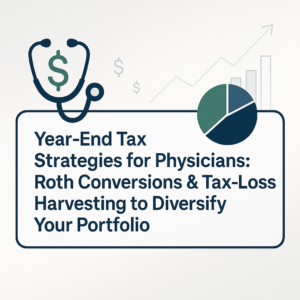Year-End Tax Strategies for Physicians: Roth Conversions & Tax-Loss Harvesting to Diversify Your Portfolio
As a busy physician, dentist, or healthcare professional, your focus is on patient care. But smart financial planning—especially as we approach year-end—can help you build lasting wealth and minimize taxes without adding complexity to your life. In this comprehensive guide, we’ll explore two time-sensitive, high-impact strategies:
- Strategic Roth IRA Conversions to lock in tax advantages.
- Capital loss harvesting and tax-free gains realization to rebalance and diversify.
These tactics leverage specific 2025 tax events to maximize your after-tax wealth and reduce future tax burdens. Let’s dive in.
Why Year-End Planning Matters for Healthcare Professionals
Doctors, dentists, and allied health specialists often find themselves in higher tax brackets due to elevated incomes. Without proactive planning, you could face substantial tax bills that erode your hard-earned gains. By focusing on year-end strategies, you can:
- Minimize taxable income in the current year.
- Convert tax-deferred assets into tax-free buckets.
- Harvest losses and gains to rebalance without extra tax.
- Achieve long-term portfolio diversification.
These steps not only reduce your tax liability but also set you up for smoother financial growth and easier retirement planning.
Strategy 1: Strategic Roth IRA Conversions
What Is a Roth IRA Conversion?
A Roth IRA conversion moves assets from a Traditional IRA (or other tax-deferred accounts) into a Roth IRA. In a conversion, the transferred amount is added to your taxable income, but future growth and withdrawals (after age 59½ and following the five-year rule) are tax-free.
Why It Works for High-Income Physicians
Physicians and dentists who make generous charitable donations or have large itemized deductions in the current year can “create” tax space—also known as deduction room—to absorb a Roth conversion without boosting their tax bracket. For example, a substantial donation to a Donor-Advised Fund (DAF) reduces your taxable income, allowing you to convert a significant IRA balance into Roth status at a low effective federal rate.
Step-by-Step Roth Conversion Guide
- Review Itemized Deductions: Identify any one-time, large deductions (e.g., DAF gift, qualified medical expenses, state tax pre-payments).
- Calculate Conversion “Shield”: Determine how much deduction room is available before you hit the next tax bracket.
- Select IRA Amount: Choose a conservative conversion amount—ideally equal to or slightly below your deduction room—to avoid bracket creep.
- Execute Conversion: Coordinate with your custodian to transfer assets from Traditional IRA to Roth IRA by year-end.
- Confirm Reporting: Ensure Form 8606 accurately reflects the conversion on your tax return.
Real-World Example (Name anonymized to protect the client)
Dr. Smith, a cardiologist, donated $50,000 to a DAF in 2025. This gift reduced her taxable income, opening a “conversion shield” under the 22% federal bracket. By converting $50,000 from her Traditional IRA to a Roth IRA, she accelerated tax-free growth on that balance, ensuring no additional federal tax was due on the conversion.
Outcome: Dr. Smith secured tax-free retirement funds and preserved her lower tax bracket status. Over 20 years, assuming a 6% annual return, those converted funds could grow by more than $160,000 tax-free.
Strategy 2: Tax-Loss Harvesting & Tax-Free Gains for Diversification
Understanding Capital Losses and Gains
When you sell an investment for less than your cost basis, you realize a capital loss. These losses offset capital gains dollar-for-dollar—and up to $3,000 per year against ordinary income. Unused losses carry forward indefinitely.
Conversely, selling investments at a gain triggers capital gains tax. Long-term gains (assets held over 1 year) benefit from favorable rates (0%, 15%, or 20%), but they still eat into your returns.
Why Leverage Losses Now?
If you’ve incurred significant losses—such as a crypto investment write-off—you can harvest equivalent gains from appreciated assets without paying tax, effectively “rebalancing” your book.
Two-Part Diversification Plan
- Rebalance: Realize a portion of gains in your accounts to meet target allocations.
- Reduce Concentration Risk: Sell high-concentration holdings (e.g., large position in a single stock) to diversify across sectors or low-cost index funds.
Case Study: Dr. Patel’s Apple Stock Position (Anonymized)
Dr. Patel held $360,000 of Apple shares with massive unrealized gains. Meanwhile, a prior $100,000 crypto loss sat unused. By harvesting $100,000 of gains—$23,000 at Custodian A and $77,000 from Apple—she net zeroed her taxable gains. This allowed a $200,000+ sale of Apple to diversify into a broad market ETF, all without incurring new tax.
Implementation Checklist
- Obtain a formal loss report for crypto or other losses.
- Identify accounts with gains and calculate netting potential.
- Prioritize sales by highest cost basis to minimize realized gain per dollar sold.
- Execute trades before year-end, ensuring settlement dates fall within the tax year.
- Document all transactions for your tax preparer.
Compliance & Best Practices for RIA-Recommended Strategies
As a Registered Investment Advisor, we adhere strictly to marketing and fiduciary regulations. All examples in this guide are hypothetical and for illustrative purposes only. Before implementing any strategy, please consult with your tax advisor to confirm suitability based on your individual circumstances.
Integrating These Strategies into Your Financial Plan
Year-end tax moves should align with your overall financial objectives. At Mainstay Capital, we follow a disciplined financial planning process that ensures every action—whether Roth conversion or tax-loss harvesting—fits within your long-term roadmap.
Our holistic approach covers:
- Cash flow and debt management.
- Retirement and college funding.
- Investment management and asset allocation.
- Tax optimization and insurance reviews.
Learn more about our comprehensive services designed for healthcare professionals.
Getting Started: Next Steps for Busy Healthcare Professionals
Ready to seize these year-end opportunities? Here’s how to proceed:
- Gather your 2025 tax documents: charitable donation receipts, cost basis reports, and prior-year tax returns.
- Schedule a brief strategy call with our team to review your deduction room and loss carryforwards.
- Approve the proposed Roth conversion amount and loss/gain harvesting plan.
- Monitor execution and confirm trade dates to ensure inclusion in the current tax year.
At Mainstay Capital, we make it simple. Who we are and what drives us is helping physicians and dentists achieve financial clarity and confidence.
Schedule your year-end strategy session today: Book a call with our team.






